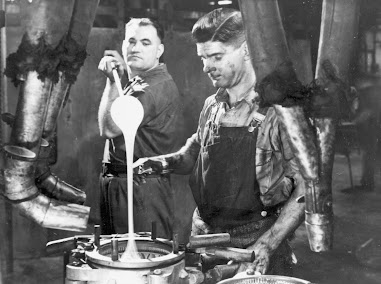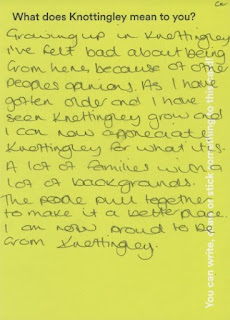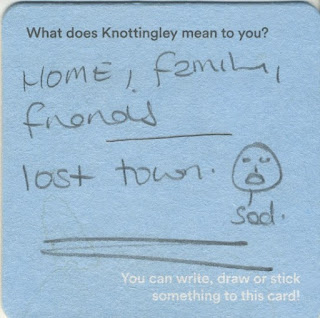Join us on Wednesday 23rd November 2022 for the Knottingley: Fire & Water event.
 |
Date: Wednesday 23rd November 2022
Time: 5:00pm - 8:00pm
Location: Knottingley Town Hall, Stoelzle Flaconnage factory & Allied Glass factory.
Join us for a celebration of Knottingley’s industrial heritage, through an innovative artwork and community event by artist David Appleyard.
See Knottingley’s iconic industrial buildings illuminated with colour and historic photographs, explore what Knottingley means to local people in a display at the Town Hall, and enjoy free food and drink, plus entertainment from Knottingley Silver Band.
- 5:00pm
– Start your evening at Knottingley Town Hall, with a display exploring
what Knottingley means to you.
- 5:45pm
– Make your way along Weeland Road to Stoelzle Flaconnage, viewing the
illuminated chimneys of Knottingley’s glass factories on your way. See
historic images of Knottingley’s industrial past projected onto the
buildings of the Old Vicarage.
- 6:00pm
& 7:00pm – Enjoy free food and drink and entertainment from
Knottingley Silver Band.
- 8:00pm – Event ends.
The event is free for everyone.
The project has been commissioned by Wakefield Museums
& Castles, funded by Arts Council England, and supported by Stoelzle
Flaconnage and Allied Glass.
Read on to discover how this artwork has been developed...
Knottingley: Fire & Water explores the industrial heritage of Knottingley.
Funded by Arts Council England, the project aims to celebrate and share the industrial heritage of Knottingley through a public artwork.
 |
| Workers at Bagley's Glassworks pouring molten glass from a gathering rod into a mould |
The artwork has been developed in collaboration with the local community, and uses the museum's collections, plus stories and memories from the community, as it's inspiration. It focuses on the key industries of glassmaking and shipbuilding in the town.
Yorkshire-based artist David Appleyard has worked with the community to create a public artwork that brings together the glassmaking and shipbuilding industries. Find out more about David's appointment.
Postcards
David distributed postcards and beermats in various community venues in Knottingley, asking people to answer the question 'What does Knottingley mean to you?'.
The responses have been varied, from people sharing how much they appreciate the community in the town, to others expressing how much they miss some of the facilities and industries that no longer exist.
Here is a sample of some of the responses we've received. If you'd like to add your own thoughts, email museums@wakefield.gov.uk.
Oral histories
As part of the Knottingley: Fire & Water project, we went out and about in Knottingley, chatting to local people who have worked in the glassmaking industry, or have memories of glassmaking or shipbuilding in the town. We recorded interviews with some of these people and learned about their fascinating and often entertaining experiences.
Here are some extracts from the interviews, as well as some recorded in 2014:
"the only school trips we went on were to see t'launches, when they were launching a boat. We used to go to watch every launch and we stood on t'canal. And then they realised that we were getting wet through...they made the mistake of putting us here, and the boat used to go in and a tidal wave would come back and [imitates a splashing sound]. I used to love getting wet through, 'cause then you went home!" [Jean Marriner]
 |
| Launch of the 'Helmsdale H' ship at Harkers shipyard in Knottingley. |
"I've seen a number of changes [at Stoelzle Flaconnage, former Bagley's, glass factory]. When I first started we had a beer run, we could have beer on an afternoon, because of the unsociable hours, also on a Sunday dinner. We also, at the hot end, if you're feeling a bit peckish, we can cook breakfast in the mould ovens, ranging from bacon to sausage and on nights we've even been known to put a full joint of beef in" [Frank Causier].
"We did all sorts in the decorating [department]. They had machines that did screen printing, we used to do that and then mainly I used to do fruit sets and they were done by transfers, or we did some with spotting. Also have you seen those apothecary jars that Bagley's used to do? I used to spray those and the spray for them is based on gold. We used to have a screen at the back where we sprayed, and they used to save the cloths because they got more money back from the gold out of the cloths that they paid for it in the first place" [Edna Murgatroyd}
 |
| A Bagley's Glassworks vase, decorated with flowers |






my mam and late first husband worked at Greggs glass works the correct name was Hope Glass works,if i can help with any information i am happy to help
ReplyDeleteHi! We'd love to hear more about their story - please get in touch via email at museums@wakefield.gov.uk and we'll find a time to chat!
ReplyDelete